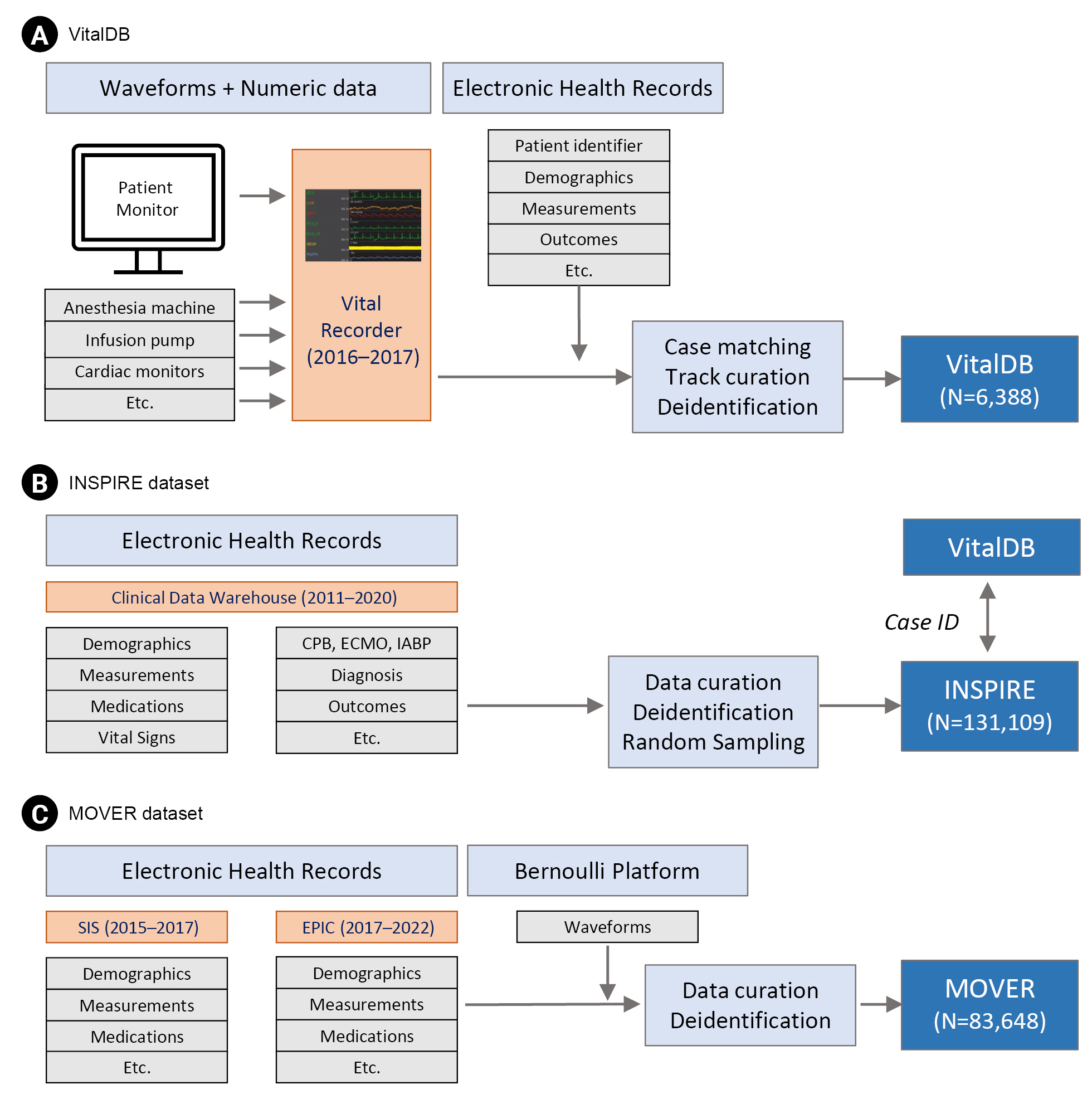Anesth Pain Med.
2023 Jul;18(3):213-219. 10.17085/apm.23076.
Open datasets in perioperative medicine: a narrative review
- Affiliations
-
- 1Department of Anesthesiology and Pain Medicine, Seoul National University College of Medicine, Seoul National University Hospital, Seoul, Korea
- KMID: 2547029
- DOI: http://doi.org/10.17085/apm.23076
Abstract
- With the growing interest of researchers in machine learning and artificial intelligence (AI) based on large data, their roles in medical research have become increasingly prominent. Despite the proliferation of predictive models in perioperative medicine, external validation is lacking. Open datasets, defined as publicly available datasets for research, play a crucial role by providing high-quality data, facilitating collaboration, and allowing an objective evaluation of the developed models. Among the available datasets for surgical patients, VitalDB has been the most widely used, with the Medical Informatics Operating Room Vitals and Events Repository recently launched and the Informative Surgical Patient dataset for Innovative Research Environment expected to be released soon. For critically ill patients, the available resources include the Medical Information Mart for Intensive Care, the eICU Collaborative Research Database, the Amsterdam University Medical Centers Database, and the High time Resolution ICU Dataset, with the anticipated release of the Intensive Care Network with Million Patients’ information for the AI Clinical decision support system Technology dataset. This review presents a detailed comparison of each to enrich our understanding of these open datasets for data science and AI research in perioperative medicine.
Keyword
Figure
Reference
-
1. Yoon HK, Yang HL, Jung CW, Lee HC. Artificial intelligence in perioperative medicine: a narrative review. Korean J Anesthesiol. 2022; 75:202–15.
Article2. Sessler DI. Big Data–and its contributions to perioperative medicine. Anaesthesia. 2014; 69:100–5.
Article3. Notice to the Secretary of HHS Breach of Unsecured Protected Health Information. U.S. Department of Health & Human Services [Internet]. [cited 2023 Jun 25]. Available from https://ocrportal.hhs.gov/ocr/breach/breach_report.jsf.4. Sjoding MW, Dickson RP, Iwashyna TJ, Gay SE, Valley TS. Racial bias in pulse oximetry measurement. N Engl J Med. 2020; 383:2477–8.
Article5. Komorowski M, Celi LA, Badawi O, Gordon AC, Faisal AA. The Artificial Intelligence Clinician learns optimal treatment strategies for sepsis in intensive care. Nat Med. 2018; 24:1716–20.
Article6. Jiang LY, Liu XC, Nejatian NP, Nasir-Moin M, Wang D, Abidin A, et al. Health system-scale language models are all-purpose prediction engines. Nature;2023. doi: 10.1038/s41586-023-06160-y. [Epub ahead of print].7. Lee HC, Park Y, Yoon SB, Yang SM, Park D, Jung CW. VitalDB, a high-fidelity multi-parameter vital signs database in surgical patients. Sci Data. 2022; 9:279.
Article8. Lee HC, Jung CW. Vital Recorder-a free research tool for automatic recording of high-resolution time-synchronized physiological data from multiple anaesthesia devices. Sci Rep. 2018; 8:1527.9. Moody GB, Mark RG, Goldberger AL. PhysioNet: a research resource for studies of complex physiologic and biomedical signals. Comput Cardiol. 2000; 27:179–82.
Article10. Samad M, Rinehart J, Angel M, Kanomata Y, Baldi P, Cannesson M. MOVER: Medical Informatics Operating Room Vitals and Events Repository. medRxiv. 2023; 2023.03.03.23286777.
Article11. Sauer CM, Dam TA, Celi LA, Faltys M, De La Hoz MAA, Adhikari L, et al. Systematic review and comparison of publicly available ICU aata sets-a decision guide for clinicians and data scientists. Crit Care Med. 2022; 50:e581–8.12. Moody GB, Mark RG. The impact of the MIT-BIH arrhythmia database. IEEE Eng Med Biol Mag. 2001; 20:45–50.
Article13. Johnson AEW, Pollard TJ, Shen L, Lehman LWH, Feng M, Ghassemi M, et al. MIMIC-III, a freely accessible critical care database. Sci Data. 2016; 3:160035.
Article14. Johnson AEW, Bulgarelli L, Shen L, Gayles A, Shammout A, Horng S, et al. MIMIC-IV, a freely accessible electronic health record dataset. Sci Data. 2023; 10:1.
Article15. Johnson AEW, Pollard TJ, Berkowitz SJ, Greenbaum NR, Lungren MP, et al. MIMIC-CXR, a de-identified publicly available database of chest radiographs with free-text reports. Sci Data. 2019; 6:317.
Article16. Pollard TJ, Johnson AEW, Raffa JD, Celi LA, Mark RG, Badawi O. The eICU Collaborative Research Database, a freely available multicenter database for critical care research. Sci Data. 2018; 5:180178.
Article17. Thoral PJ, Peppink JM, Driessen RH, Sijbrands EJG, Kompanje EJO, Kaplan L, et al. Sharing ICU Patient Data Responsibly Under the Society of Critical Care Medicine/European Society of Intensive Care Medicine Joint Data Science Collaboration: The Amsterdam University Medical Centers Database (AmsterdamUMCdb) Example. Crit Care Med. 2021; 49:e563–77.
Article18. Hyland SL, Faltys M, Hüser M, Lyu X, Gumbsch T, Esteban C, et al. Early prediction of circulatory failure in the intensive care unit using machine learning. Nat Med. 2020; 26:364–73.
Article19. Stupple A, Singerman D, Celi LA. The reproducibility crisis in the age of digital medicine. NPJ Digit Med. 2019; 2:2.
Article
- Full Text Links
- Actions
-
Cited
- CITED
-
- Close
- Share
- Similar articles
-
- Artificial intelligence in perioperative medicine: a narrative review
- Preoperative risk evaluation and perioperative management of patients with obstructive sleep apnea: a narrative review
- Weightism in Asia: A Narrative Review and Implications for Practice
- Perioperative nutrition support: a narrative review
- Minimally Invasive Surgery versus Open Surgery for Adolescent Idiopathic Scoliosis: A Systematic Review and Meta-Analysis


